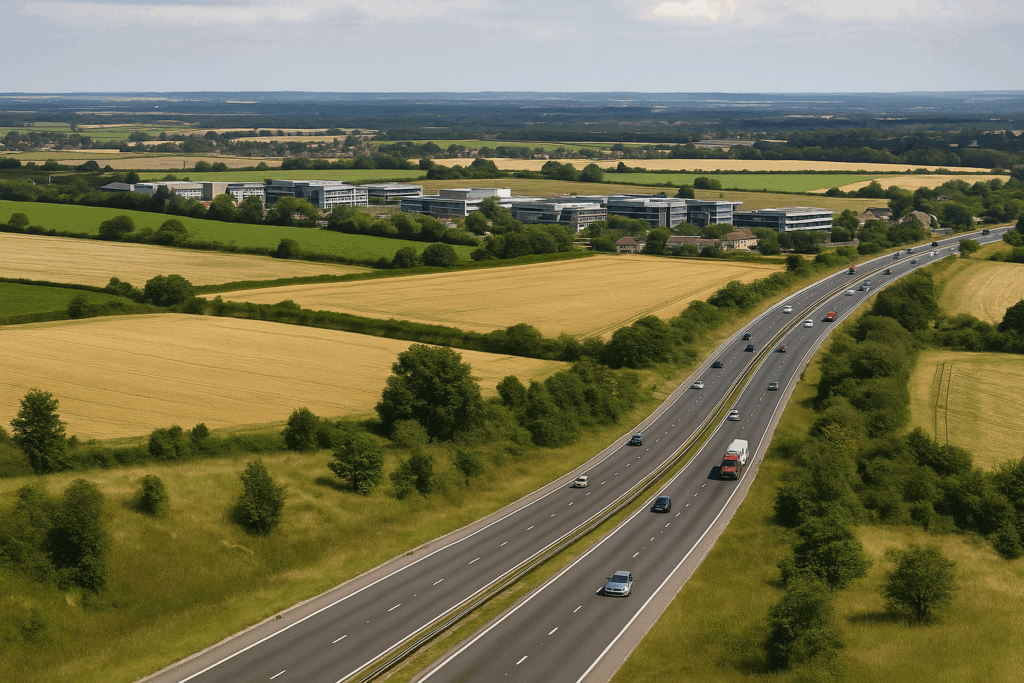The Oxford-Cambridge growth corridor is becoming one of the most closely watched areas in the UK for regional development. Spanning two of the world’s most respected universities and a fast-growing centre in Milton Keynes, it blends academic excellence with real potential for economic transformation. Far from a distant ambition, the corridor is now a live project with concrete goals in infrastructure, housing and technology.
This region has drawn attention not only for its assets, but for how well they connect. The Oxford-Cambridge growth corridor represents an attempt to rethink where and how innovation happens in the UK. Instead of relying heavily on London, planners and institutions are working to cultivate another powerful source of growth — one that links research, people and businesses across a wider geography.
Why the Oxford-Cambridge corridor is gaining momentum

What sets this corridor apart is the unique mix of world-leading research institutions, highly skilled talent, and rapidly expanding high-tech industries. Between Oxford and Cambridge, there are numerous science and innovation parks that already support thousands of jobs in fields such as biotechnology, AI and green energy. Milton Keynes adds infrastructure and logistical capacity to this landscape.
Forecasts suggest that the Oxford-Cambridge growth corridor could generate around £250 billion for the UK economy by 2050. But this is not just about numbers — it’s about carefully designing a region that’s better connected, more affordable, and fully capable of supporting high-value industries without relying solely on the capital.
How government and local strategies align
Central government has identified this corridor as a national asset. Policies once framed under the “Oxford-Cambridge Arc” now translate into targeted investments, particularly in housing delivery and integrated transport. The East West Rail project, one of the largest infrastructure undertakings in the area, is a clear example of that commitment.
The Oxford-Cambridge growth corridor also fits into the UK’s wider goal of reducing long-standing economic imbalance. By creating high-quality jobs and infrastructure outside of London, the corridor is part of a broader strategy to support inclusive, regionally distributed growth — something long overdue in national spatial planning.
Connecting the dots: transport and mobility
Transport is a crucial pillar of the corridor’s future. The East West Rail line will reconnect Oxford and Cambridge by train, a service that has not existed for over 50 years. This isn’t just about convenience — it’s about enabling collaboration between institutions and reducing car dependency in a densely populated zone. Road upgrades and new cycle routes are also part of the plan. These changes aim to make travel within the Oxford-Cambridge growth corridor faster, safer and more sustainable, especially for workers and students commuting between hubs.
Building for the future: housing with purpose
With growth comes the need for housing — not just in quantity, but in quality and location. The proposal to build up to one million new homes by 2050 has sparked debate, but also underscores how much demand the corridor is generating. Rather than sprawl, the focus is on compact, well-served communities. For the Oxford-Cambridge growth corridor to succeed, it must offer more than just jobs — it must provide places where people can genuinely thrive.
The innovation engine behind the region
Oxford and Cambridge are global research giants, but their influence extends well beyond university walls. Each year, they spin out dozens of companies and collaborate with leading firms in life sciences, computing and materials science. These connections anchor a broader innovation ecosystem that stretches across the entire corridor.
In the Oxford-Cambridge growth corridor, research campuses like Harwell and the Cambridge Biomedical Campus play a vital and growing role. They attract international companies, support advanced research initiatives, and help train the skilled workforce of tomorrow — making the region more than just a sum of its parts.
The private sector’s role in expanding impact
What amplifies this potential is the private sector’s growing involvement. From startups in deep tech to established firms in healthcare and clean energy, businesses are increasingly locating themselves within the corridor to be close to talent, funding and collaborative opportunities. This makes the Oxford-Cambridge growth corridor especially fertile ground for partnerships that drive both economic and social outcomes.
What could hold the corridor back
While the vision is clear and well-defined, the path isn’t without its challenges. Delays in major transport projects, planning disagreements between local councils, and persistent resistance to new developments have all slowed measurable progress. These are not minor issues — they directly affect timelines and public confidence in delivery.
To keep the Oxford-Cambridge growth corridor on track and progressing, there needs to be stronger coordination across agencies and consistent dialogue with local communities. Short-term disruption must be weighed carefully against long-term public benefit, but that message has to be communicated clearly, honestly, and backed by tangible results.
Growth and environment: a necessary balance
Environmental concerns are another key consideration. The corridor crosses several protected landscapes and biodiversity zones, raising important questions about how expansion should be handled. Growth that ignores these issues risks losing both public trust and ecological integrity. From carbon-neutral housing to nature-based flood protection, the Oxford-Cambridge growth corridor has an opportunity to show how economic ambition and environmental responsibility can go hand in hand.
Why the UK needs this corridor to succeed
Beyond the region itself, the corridor significantly strengthens the UK’s global competitiveness in research, technology and advanced manufacturing. It adds resilience by decentralising research and innovation activity across key hubs, and offers companies a strategic alternative to the high costs, space limitations and regulatory constraints of operating exclusively in London.
The Oxford-Cambridge growth corridor could also reshape how we think about long-term productivity and regional investment. Instead of drawing people to already overburdened urban centres, it aims to bring meaningful opportunity closer to where people already live and work — a shift that could benefit overlooked or underserved parts of the UK as well.
Making growth more inclusive
Not everyone currently benefits from the region’s success. Addressing that imbalance means expanding skills training, improving digital infrastructure and supporting local businesses. Growth without inclusion risks deepening inequality rather than solving it. If the Oxford-Cambridge growth corridor truly wants to be a model for the future, it must be one where more people can participate and prosper.
Summary table: strategic priorities in the Oxford-Cambridge growth corridor
To make sense of where the Oxford-Cambridge growth corridor is headed, it’s helpful to lay out the key priorities guiding current development. These cover transport, housing, innovation, environmental policy and workforce strategy. The table below summarises the main action areas. The information reflects government documents and strategic plans published up to late 2024, all of which remain current and are being implemented throughout 2025.
| Area of Development | Key Initiative | Impact |
|---|---|---|
| Infrastructure | East West Rail, road upgrades | Better regional connectivity |
| Housing | Up to 1 million new homes by 2050 | More liveable, sustainable communities |
| Innovation Ecosystem | University-industry partnerships | Growth in science, R&D and entrepreneurship |
| Environment | Net-zero building and green corridors | Reduced ecological impact |
| Skills and Inclusion | Education and job training programmes | Broader access to economic opportunity |


